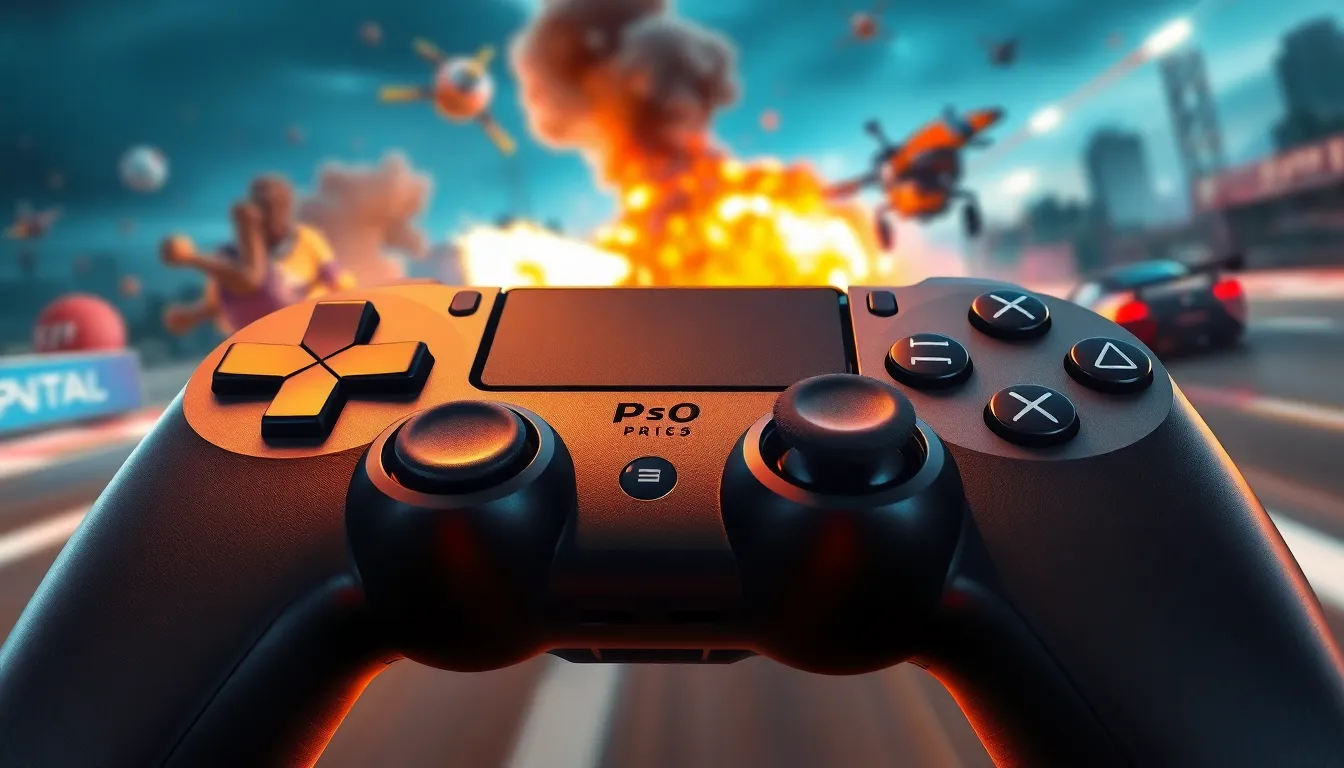In the world of gaming, feeling every explosion and jump is as crucial as the graphics on screen. Enter controller haptics feedback, the unsung hero that turns mere button mashing into a full-body experience. Imagine your controller buzzing with excitement as you race through virtual streets or rumbling like a mini earthquake when you take a hit. It’s like having a personal cheerleader in your hands, urging you to conquer every challenge.
Table of Contents
ToggleOverview of Controller Haptics Feedback
Controller haptic feedback plays a critical role in enhancing the gaming experience. It introduces sensations that amplify visuals, making gameplay more engaging.
Definition and Importance
Haptic feedback refers to the tactile sensations produced by controllers during gameplay. This technology translates in-game actions into physical responses. For example, players might feel a rumble when crashing in a racing game or a subtle vibration during a tense moment in an adventure game. Such sensations foster immersion by connecting players emotionally to the game. Studies showed that over 80% of gamers feel that haptic feedback enriches their experience, making it a vital component in modern gaming.
Evolution of Haptic Technology
Haptic technology has evolved significantly since its inception. Early gaming controllers featured basic vibration motors, offering limited feedback. Developers introduced more sophisticated systems, such as adaptive triggers and precise vibration patterns, to enhance sensory experiences. Recent advancements include the integration of advanced motors that can produce varied textures and sensations. The introduction of dual actuators allows for more nuanced feedback, enriching the emotional experience in gameplay. These developments reflect the gaming industry’s commitment to innovation and player satisfaction.
Types of Haptic Feedback

Haptic feedback comes in various forms, enhancing player engagement. Each type provides distinct advantages that contribute to an immersive gaming experience.
Vibration Feedback
Vibration feedback is the most common form in controllers. It produces rumbling sensations during specific events, like explosions or collisions. Controllers equipped with vibration motors create a consistent tactile response. Players experience immediate reactions that mirror in-game actions. For example, accelerating in a racing game generates stronger vibrations, while slower movements result in subtler feedback. This variability helps players connect emotionally with their gameplay.
Force Feedback
Force feedback involves the application of resistance and force sensations. Using motors with torque, controllers simulate real-world interactions, making gameplay more engaging. When a player navigates through different terrains or faces resistance during challenges, force feedback enhances the experience significantly. For instance, a player might feel resistance when pulling back an arrow in an archery game, adding realism to the action. This realistic force sensation allows players to understand their in-game actions better.
Texture Simulation
Texture simulation offers an advanced haptic experience by mimicking surface details. Controllers with this technology can simulate feelings like rough, smooth, or bumpy textures. As players encounter various surfaces in a game, they can sense these distinct qualities through their controllers. For example, traversing gravel versus grass generates different feedback sensations, enriching the overall immersion. This nuanced feedback deepens the connection between players and their virtual environments, making interactions more lifelike.
Applications of Controller Haptics Feedback
Controller haptic feedback serves various applications across different sectors. Its ability to enhance experiences makes it invaluable in gaming, virtual reality, and simulations.
Gaming Industry
The gaming industry benefits immensely from haptic feedback technologies. Players gain immersive sensations that reflect in-game actions, creating vivid experiences. Racing games utilize vibrations to simulate speed and road conditions. Action titles provide tactile responses during dramatic moments, intensifying the overall gameplay. Studies show that over 80% of gamers perceive haptic feedback as crucial in maintaining engagement, confirming its essential role in player satisfaction. Leading console manufacturers continuously innovate, integrating more advanced haptic systems to ensure players remain captivated and motivated.
Virtual Reality
Virtual reality (VR) applications utilize haptic feedback to create a lifelike environment. Controllers equipped with advanced haptics enable users to interact with virtual worlds naturally. The sensation of touch enhances immersion, allowing users to feel virtual objects as if they exist in reality. As players navigate VR environments, haptic feedback provides cues that match visual elements, further blurring the lines between the real and virtual worlds. This synergy between sight and touch elevates the overall VR experience, fostering deeper engagement and satisfaction.
Simulations and Training
Simulations and training programs rely heavily on haptic feedback for realism. Professionals use haptic-enabled devices in fields like aviation and surgery to simulate real-world scenarios. For instance, flight simulators deliver precise sensations that mimic aircraft controls, enhancing pilot training. In medical simulations, haptic feedback helps trainees experience the tactile sensations of procedures, improving skill acquisition. This realism translates to better preparedness in actual situations, demonstrating the practicality of haptic technology in critical training environments.
Key Players in the Market
The landscape of controller haptic feedback includes significant contributors who shape the technology through innovation and user experience.
Major Manufacturers
Sony leads the market with its DualSense controller, integrating advanced haptic technology that simulates a wide range of sensations. Microsoft follows closely, offering immersive experiences with its Xbox Series X controller, which employs sophisticated rumble motors. Nintendo also plays a crucial role with its Switch console, utilizing HD Rumble to enhance gameplay. Other notable manufacturers, such as Razer and Logitech, have developed their own controller lines that incorporate various haptic features, catering to diverse gamer preferences.
Emerging Developers
Emerging developers are swiftly gaining traction in the haptic feedback space. Companies like Thrustmaster and SCUF Gaming are introducing controllers with customizable haptic features, targeting competitive gamers. Anker has entered the market with budget-friendly options that still offer quality haptic responses. Additionally, startups like haptX are pioneering wearable haptic technology, aiming to bridge the gap between virtual and physical experiences. These innovators are pushing boundaries, demonstrating a commitment to enhancing player immersion and engagement.
Future Trends in Controller Haptics Feedback
The future of controller haptics feedback looks promising with continuous advancements in technology. Innovations aim to enhance the immersive experience for players significantly.
Innovations to Expect
Next-gen haptic systems will likely include advanced gesture recognition. Such technology allows players to interact seamlessly using touch and motion. Furthermore, integration of biometric feedback can personalize experiences based on players’ physiological responses. Companies are investing in adaptive feedback mechanisms that change based on in-game scenarios, creating a dynamic interaction. The introduction of multi-layered feedback systems is poised to provide a more nuanced experience, enabling sensations like temperature changes during gameplay. Enhanced realism is on the horizon, drawing players deeper into virtual environments and making gameplay feel lifelike.
Potential Challenges
Despite advancements, certain challenges could hinder the progress of haptic feedback technology. Cost remains a significant factor; creating intricate haptic systems often incurs high production expenses. Additionally, developers face the challenge of interface compatibility across various devices and platforms. Striking a balance between performance and battery life is essential; excessive power consumption could detract from the gaming experience. Furthermore, developers must ensure the tactile feedback aligns with users’ expectations; otherwise, it may create disconnects in immersion. Addressing these challenges is critical for the haptic feedback market to evolve and thrive in the gaming industry.
Controller haptic feedback is revolutionizing the way players engage with games. By providing tactile sensations that mirror in-game actions, it deepens emotional connections and enhances immersion. As technology continues to advance, the potential for even more sophisticated feedback systems promises to elevate the gaming experience further.
The ongoing innovation from major players and emerging developers indicates a bright future for haptic feedback. With the integration of features like gesture recognition and adaptive responses, players can expect a level of interaction that was previously unimaginable. This evolving landscape not only enriches gaming but also expands the possibilities for applications in various fields, reinforcing the significance of haptic technology in modern experiences.





